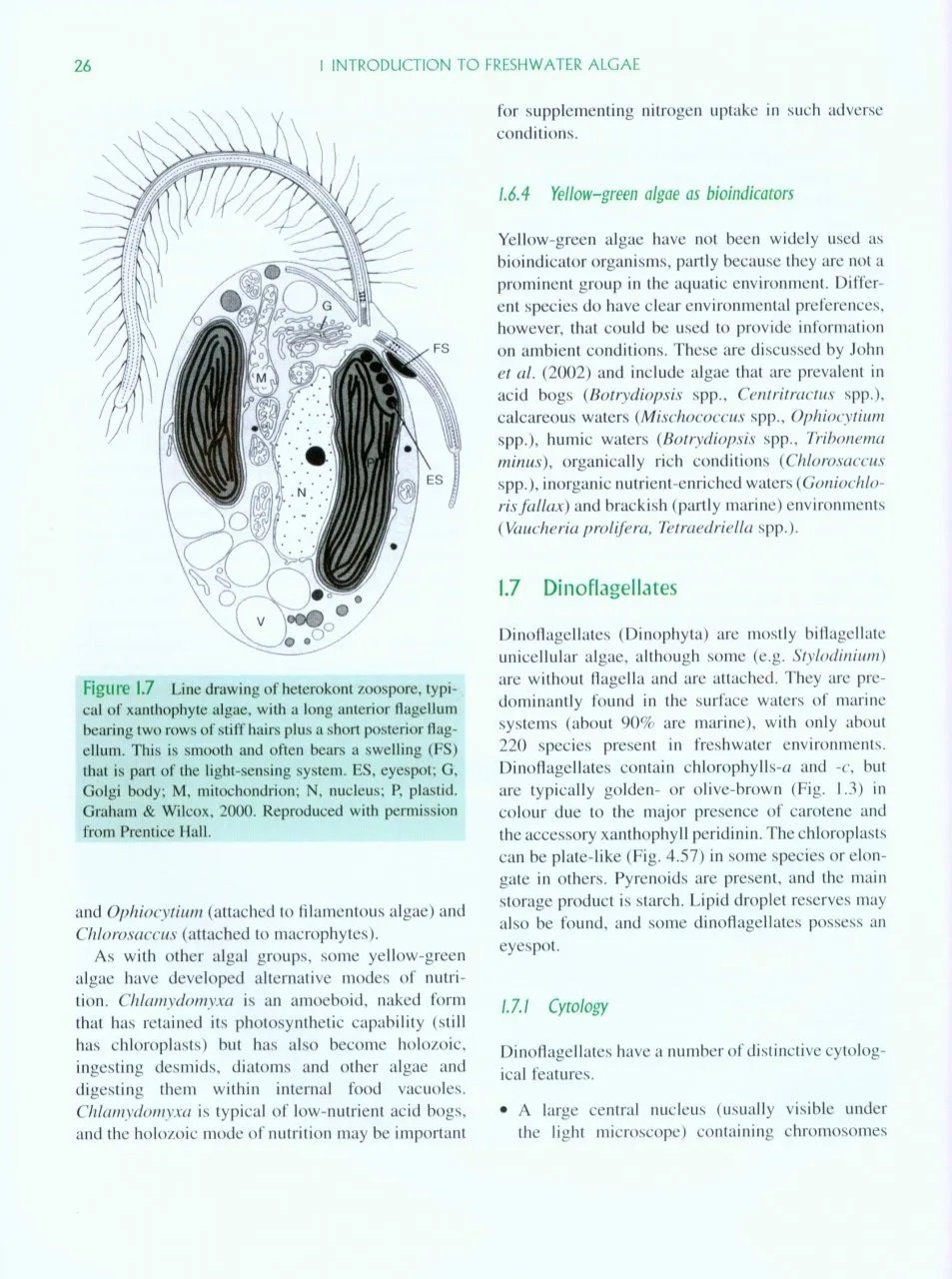This is the second edition of Freshwater Algae; the popular guide to temperate freshwater algae. This book uniquely combines practical information on sampling and experimental techniques with an explanation of basic algal taxonomy plus a key to identify the more frequently-occurring organisms. Fully revised, it describes major bioindicator species in relation to key environmental parameters and their implications for aquatic management.
Bridging the gap between simple identification texts and highly specialised research volumes, this book is used both as a comprehensive introduction to the subject and as a laboratory manual. The new edition will be invaluable to aquatic biologists for algal identification, and for all practitioners and researchers working within aquatic microbiology in industry and academia.
Preface to the First Edition ix
Preface to the Second Edition xi
Acknowledgements xiii
1 Introduction to Freshwater Algae 1
1.1 General introduction 1
1.1.1 Algae – an overview 1
1.1.2 Algae as primary producers 2
1.1.3 Freshwater environments 2
1.1.4 Planktonic and benthic algae 2
1.1.5 Size and shape 4
1.2 Taxonomic variation – the major groups of algae 5
1.2.1 Microscopical appearance 8
1.2.2 Biochemistry and cell structure 8
1.2.3 Molecular characterisation and identification 10
1.3 Blue-green algae 13
1.3.1 Cytology 13
1.3.2 Morphological and taxonomic diversity 14
1.3.3 Ecology 15
1.3.4 Blue-green algae as bioindicators 16
1.4 Green algae 17
1.4.1 Cytology 18
1.4.2 Morphological diversity 18
1.4.3 Ecology 19
1.4.4 Green algae as bioindicators 22
1.5 Euglenoids 22
1.5.1 Cytology 23
1.5.2 Morphological diversity 23
1.5.3 Ecology 24
1.5.4 Euglenoids as bioindicators 24
1.6 Yellow-green algae 24
1.6.1 Cytology 24
1.6.2 Morphological diversity 25
1.6.3 Ecology 25
1.6.4 Yellow-green algae as bioindicators 26
1.7 Dinoflagellates 26
1.7.1 Cytology 26
1.7.2 Morphological diversity 28
1.7.3 Ecology 28
1.8 Cryptomonads 29
1.8.1 Cytology 29
1.8.2 Comparison with euglenoid algae 30
1.8.3 Biodiversity 31
1.8.4 Ecology 31
1.8.5 Cryptomonads as bioindicators 32
1.9 Chrysophytes 32
1.9.1 Cytology 32
1.9.2 Morphological diversity 32
1.9.3 Ecology 32
1.9.4 Chrysophytes as bioindicators 33
1.10 Diatoms 34
1.10.1 Cytology 35
1.10.2 Morphological diversity 38
1.10.3 Ecology 40
1.10.4 Diatoms as bioindicators 41
1.11 Red algae 41
1.12 Brown algae 42
2 Sampling, Biomass Estimation and Counts of Freshwater Algae 43
A. PLANKTONIC ALGAE 43
2.1 Protocol for collection 43
2.1.1 Standing water phytoplankton 44
2.1.2 River phytoplankton 47
2.2 Mode of collection 48
2.2.1 Phytoplankton trawl net 48
2.2.2 Volume samplers 50
2.2.3 Integrated sampling 51
2.2.4 Sediment traps 52
2.3 Phytoplankton biomass 53
2.3.1 Turbidity 53
2.3.2 Dry weight and ash-free dry weight 54
2.3.3 Pigment concentrations 55
2.4 Flow cytometry: automated analysis of phytoplankton populations 60
2.5 Biodiversity of mixed-species populations: microscope counts and biovolumes 63
2.5.1 Sample preservation and processing 63
2.5.2 Chemical cleaning of diatoms 64
2.5.3 Species counts 65
2.5.4 Conversion of species counts to biovolumes 72
2.5.5 Indices of biodiversity 77
2.6 Biodiversity within single-species populations 78
2.6.1 Molecular analysis 78
2.6.2 Analytical microscopical techniques 79
B. NON-PLANKTONIC ALGAE 83
2.7 Deep-water benthic algae 84
2.7.1 Benthic-pelagic coupling 84
2.7.2 Benthic algae and sediment stability 85
2.7.3 Invertebrate grazing of benthic algae 86
2.8 Shallow-water communities 86
2.8.1 Substrate 86
2.8.2 Algal communities 89
2.9 Algal biofilms 90
2.9.1 Mucilaginous biofilms 91
2.9.2 Biomass 91
2.9.3 Taxonomic composition 92
2.9.4 Matrix structure 94
2.10 Periphyton – algal mats 95
2.10.1 Inorganic substratum 95
2.10.2 Plant surfaces 95
3 Algae as Bioindicators 101
3.1 Bioindicators and water quality 101
3.1.1 Biomarkers and bioindicators 101
3.1.2 Characteristics of bioindicators 102
3.1.3 Biological monitoring versus chemical measurements 103
3.1.4 Monitoring water quality: objectives 104
3.2 Lakes 107
3.2.1 Contemporary planktonic and attached algae as bioindicators 107
3.2.2 Fossil algae as bioindicators: lake sediment analysis 108
3.2.3 Water quality parameters: inorganic and organic nutrients, acidity and heavy metals 111
3.3 Wetlands 121
3.3.1 Marshes 121
3.3.2 Peatlands 123
3.4 Rivers 123
3.4.1 The periphyton community 123
3.4.2 River diatoms 123
3.4.3 Evaluation of the diatom community 124
3.4.4 Human impacts and diatom indices 126
3.4.5 Calculation of diatom indices 128
3.4.6 Practical applications of diatom indices 130
3.4.7 Nitrogen-fixing blue-green algae 135
3.5 Estuaries 135
3.5.1 Ecosystem complexity 136
3.5.2 Algae as estuarine bioindicators 137
4 A Key to the More Frequently Occurring Freshwater Algae 141
4.1 Introduction to the key 141
4.1.1 Using the key 141
4.1.2 Morphological groupings 142
4.2 Key to the main genera and species 142
4.3 List of algae included and their occurrence in the key 249
4.4 Algal identification: bibliography 251
Glossary 253
References 259
Index 269


























